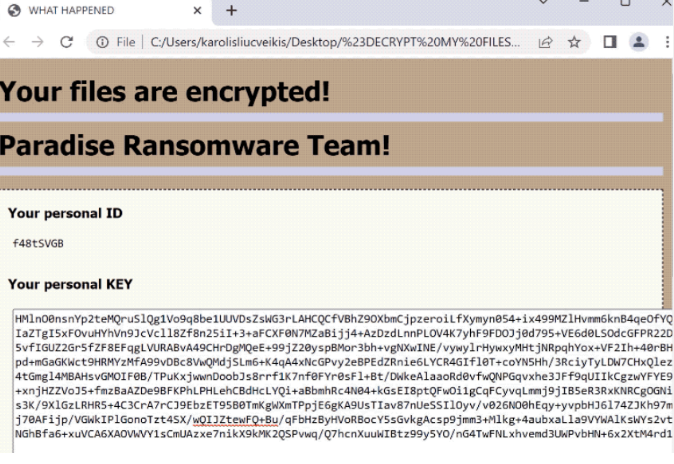What is .honkai Virus
.honkai Virus (or Honkai ransomware) refers to a file-encrypting ransomware infection, part of the Paradise ransomware family. The malware can be recognized by the .honkai extension it adds to encrypted files. The full extension also contains users’ unique IDs as well as the contact email address for the cyber criminals but it ends in .honkai. Unfortunately, once files have been encrypted, you will not be able to open them unless you acquire a special decryptor first and use it on those files. However, getting a decryptor is not easy because only the malware operators have it at this moment. Users who have backups of their files should have no issues with file recovery.
Users can tell whether files have been encrypted by the extensions added to affected files. In this situation, a long extension will be added. A text.txt file would become text.txt[unique ID].[main@paradisenewgenshinimpact.top].honkai if encrypted. The unique ID will be different for all users. The ransomware mainly targets personal files, usually photos, videos, images, and documents because they are the files users are usually most willing to pay for. The files will be unopenable unless you first use a decryptor on them. The process of obtaining the decryptor is explained in the ransom note.
When the ransomware is done encrypting files, it will drop a #DECRYPT MY FILES#.html ransom note onto the desktop. The note explains that files have been encrypted and can only be opened after they’ve been decrypted with a special decryptor. The price for the .honkai Virus decryptor is not mentioned, it supposedly depends on how quickly the victims contact the cyber criminals. The note also mentions that 3 files can be decrypted for free if they do not contain valuable information. Paying the ransom is never recommended, primarily because it does not guarantee that a decryptor will be sent. Furthermore, the money would go toward future malicious activities.
If you don’t have a backup of any of your files, file recovery will be difficult. A free .honkai Virus decryptor is not yet available, and it is unknown when one will be. It’s not impossible that it could be released eventually, which is why you should back up your encrypted files in case it does. You do need to be very careful when searching for free decryptors because there are many fake ones. NoMoreRansom is one of the best sources for free decryptors.
If you do have a backup, you can start the file recovery process as soon as you delete .honkai Virus from your computer. We recommend against attempting to manually remove .honkai Virus because it is a sophisticated infection that requires a professional program. If you incorrectly remove .honkai Virus, you could accidentally cause more damage. Therefore, to remove .honkai Virus from your computer, use a reliable anti-malware program.
How do ransomware infections enter computers?
Users with poor browsing habits are much more likely to infect their computers with malware. These users are more prone to take risks when online. For example, they tend to visit high-risk websites, open unsolicited email attachments, download copyrighted content using torrents, and click on random links and advertisements. Changing your browsing habits can help you avoid future malicious infections.
Email is the most common way that malicious actors spread ransomware. It’s a low-effort method because all that is required of cybercriminals is to send emails with malware attached to them to email addresses purchased from hacker forums. When users open the malicious files attached to those emails, their computers become infected and their data is encrypted.
Fortunately, if you know what to look for, you should be able to identify malicious emails with ease. Despite sanders claiming to be from legitimate businesses, malicious emails frequently have grammar and spelling mistakes. Think about the last time you received an email from a legitimate company that had obvious grammar and spelling mistakes. The use of generic phrases like “User,” “Member,” or “Customer” in an email that purports to be from someone whose services you use is another sign that the email could be malicious. Customers are typically addressed by name in emails from companies whose services they use because that gives the emails a more personal feel. However, cybercriminals rarely have access to users’ personal information and they target users on a large scale, so they use generic terms to address users.
It’s also worth mentioning that some malicious campaigns can be significantly more sophisticated. If cybercriminals have access to the personal information of their target, they would be able to create a sophisticated malware-carrying email. This is why it’s a good idea to scan all email attachments with anti-virus software or VirusTotal before opening them.
Torrents are also used for malware distribution. It’s no secret that torrent sites are typically poorly moderated, which makes it easy for malicious actors to upload torrents with malware. Torrents for popular entertainment content, particularly movies, TV shows, and video games, frequently contain malware. If you try to download copyrighted content for free via torrents, you are not only putting your computer in danger but also stealing because torrenting is technically content theft.
How to delete .honkai Virus from your computer
.honkai virus is a very sophisticated malicious infection that needs to be removed from your computer using anti-malware software. If you try to remove .honkai Virus manually, you risk causing your computer even more damage. It’s significantly safer and easier to use anti-malware software. And if you have your files saved in a backup, you can start file recovery as soon as you remove .honkai Virus from your computer.
.honkai Virus is detected as:
- Win32:MalwareX-gen [Trj] by Avast/AVG
- HEUR:Trojan-Ransom.Win32.Generic by Kaspersky
- Ransomware-GJJ!5CBBC1ADFD22 by McAfee
- Ransom:MSIL/Cryptid by Microsoft
- Trojan.GenericKD.65442472 by BitDefender
- A Variant Of MSIL/Filecoder.Paradise.D by ESET
- Ransom.FileCryptor.MSIL by Malwarebytes
- Ransom.MSIL.PARADISE.SMI by TrendMicro
Offers
Download Removal Toolto scan for .honkai VirusUse our recommended removal tool to scan for .honkai Virus. Trial version of provides detection of computer threats like .honkai Virus and assists in its removal for FREE. You can delete detected registry entries, files and processes yourself or purchase a full version.
More information about SpyWarrior and Uninstall Instructions. Please review SpyWarrior EULA and Privacy Policy. SpyWarrior scanner is free. If it detects a malware, purchase its full version to remove it.

WiperSoft Review Details WiperSoft (www.wipersoft.com) is a security tool that provides real-time security from potential threats. Nowadays, many users tend to download free software from the Intern ...
Download|more


Is MacKeeper a virus? MacKeeper is not a virus, nor is it a scam. While there are various opinions about the program on the Internet, a lot of the people who so notoriously hate the program have neve ...
Download|more


While the creators of MalwareBytes anti-malware have not been in this business for long time, they make up for it with their enthusiastic approach. Statistic from such websites like CNET shows that th ...
Download|more
Quick Menu
Step 1. Delete .honkai Virus using Safe Mode with Networking.
Remove .honkai Virus from Windows 7/Windows Vista/Windows XP
- Click on Start and select Shutdown.
- Choose Restart and click OK.

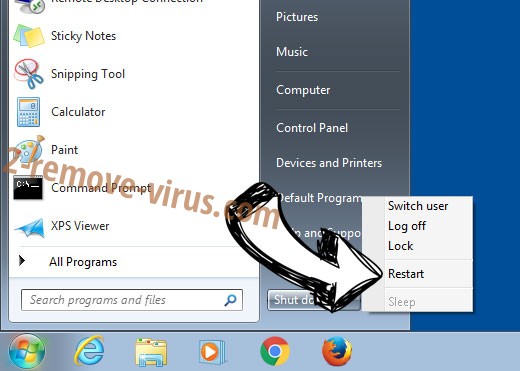
- Start tapping F8 when your PC starts loading.
- Under Advanced Boot Options, choose Safe Mode with Networking.

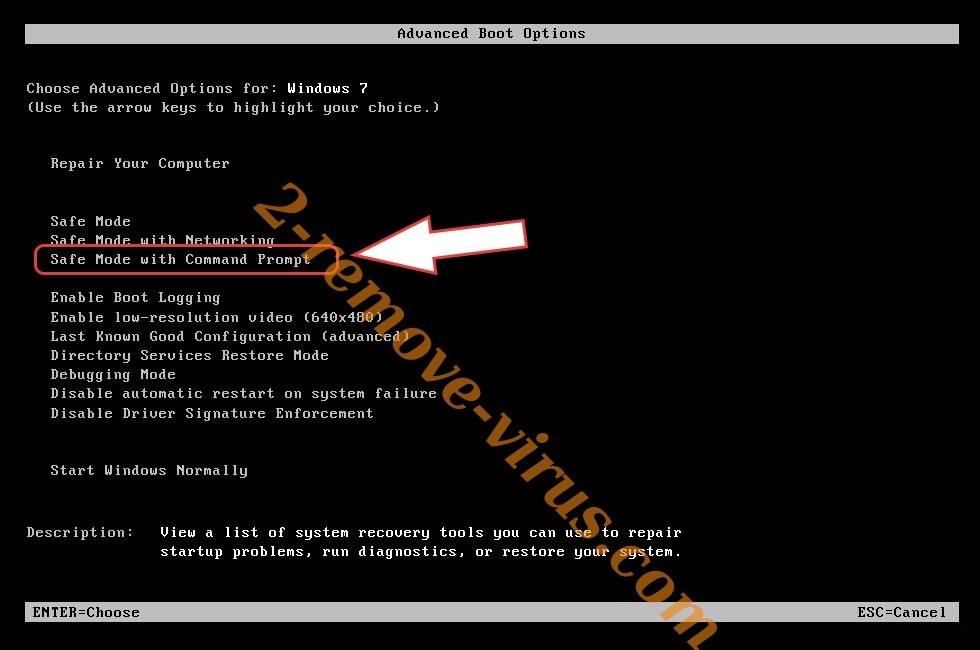
- Open your browser and download the anti-malware utility.
- Use the utility to remove .honkai Virus
Remove .honkai Virus from Windows 8/Windows 10
- On the Windows login screen, press the Power button.
- Tap and hold Shift and select Restart.

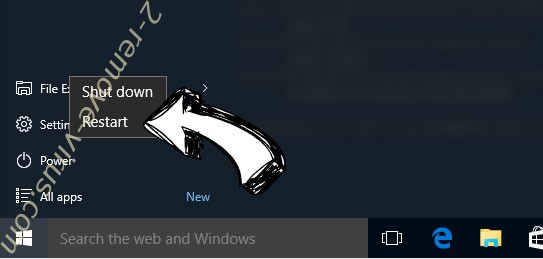
- Go to Troubleshoot → Advanced options → Start Settings.
- Choose Enable Safe Mode or Safe Mode with Networking under Startup Settings.

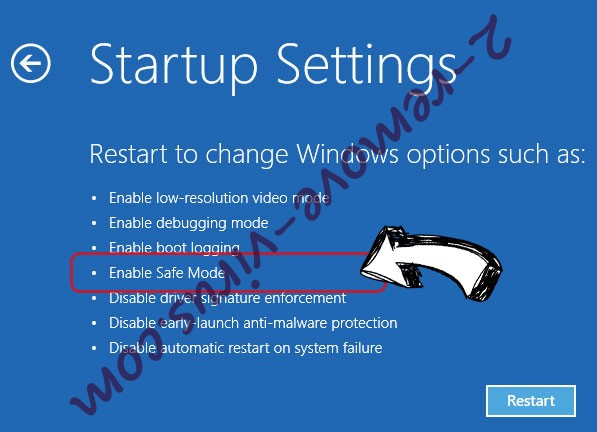
- Click Restart.
- Open your web browser and download the malware remover.
- Use the software to delete .honkai Virus
Step 2. Restore Your Files using System Restore
Delete .honkai Virus from Windows 7/Windows Vista/Windows XP
- Click Start and choose Shutdown.
- Select Restart and OK


- When your PC starts loading, press F8 repeatedly to open Advanced Boot Options
- Choose Command Prompt from the list.

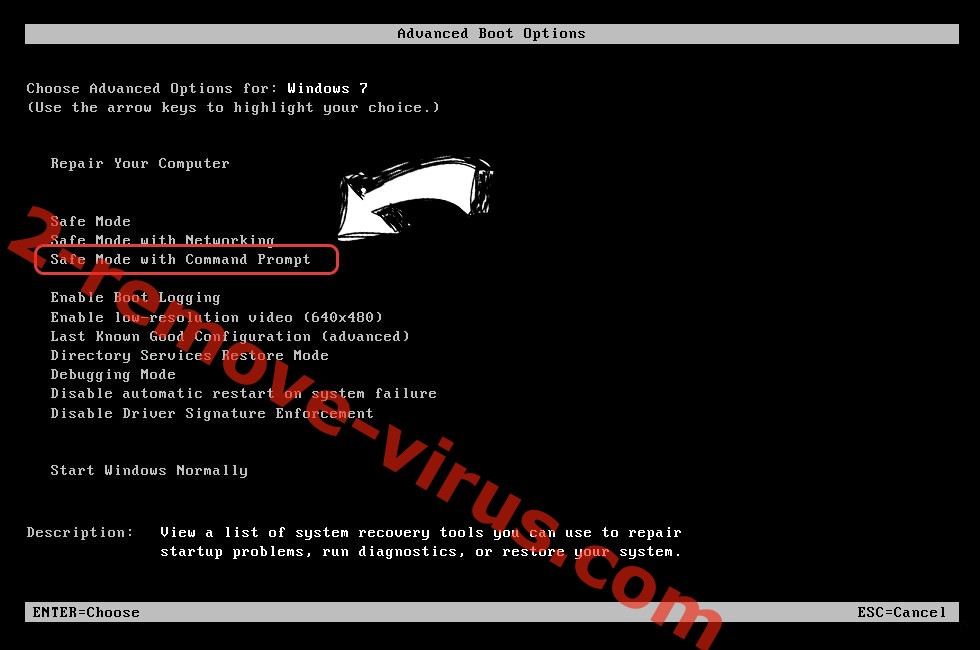
- Type in cd restore and tap Enter.

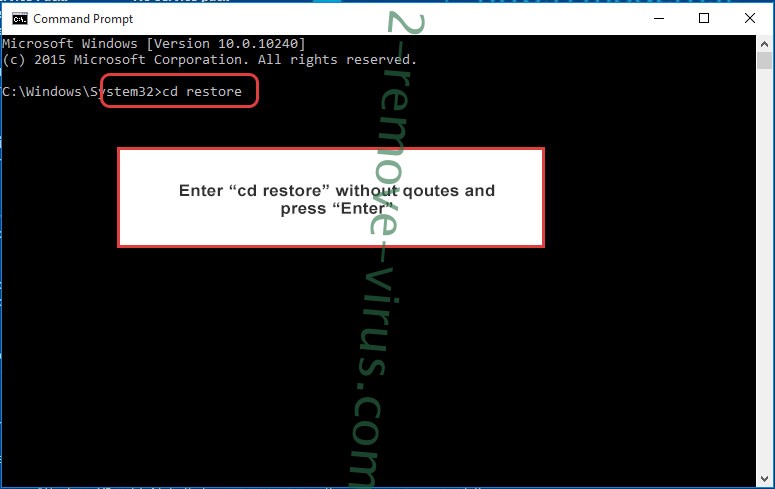
- Type in rstrui.exe and press Enter.

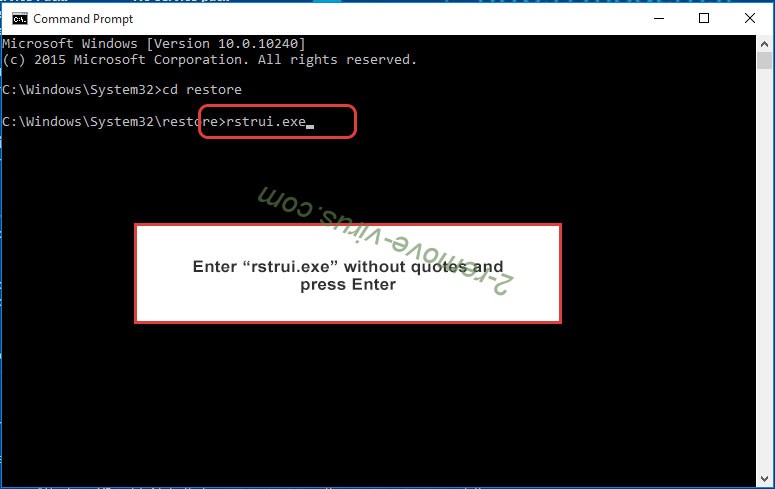
- Click Next in the new window and select the restore point prior to the infection.

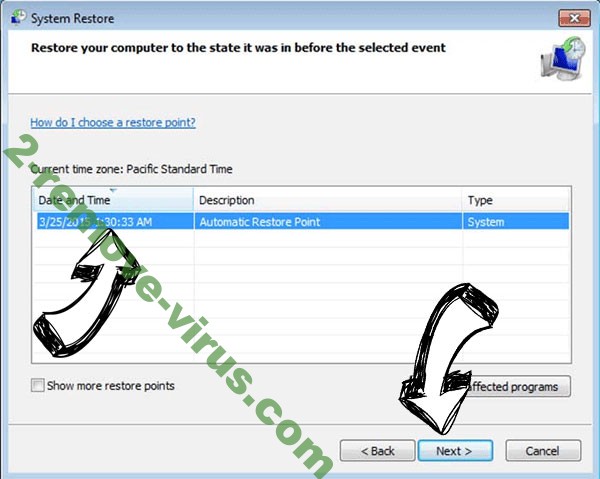
- Click Next again and click Yes to begin the system restore.

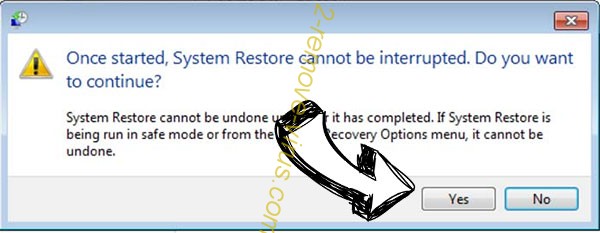
Delete .honkai Virus from Windows 8/Windows 10
- Click the Power button on the Windows login screen.
- Press and hold Shift and click Restart.


- Choose Troubleshoot and go to Advanced options.
- Select Command Prompt and click Restart.

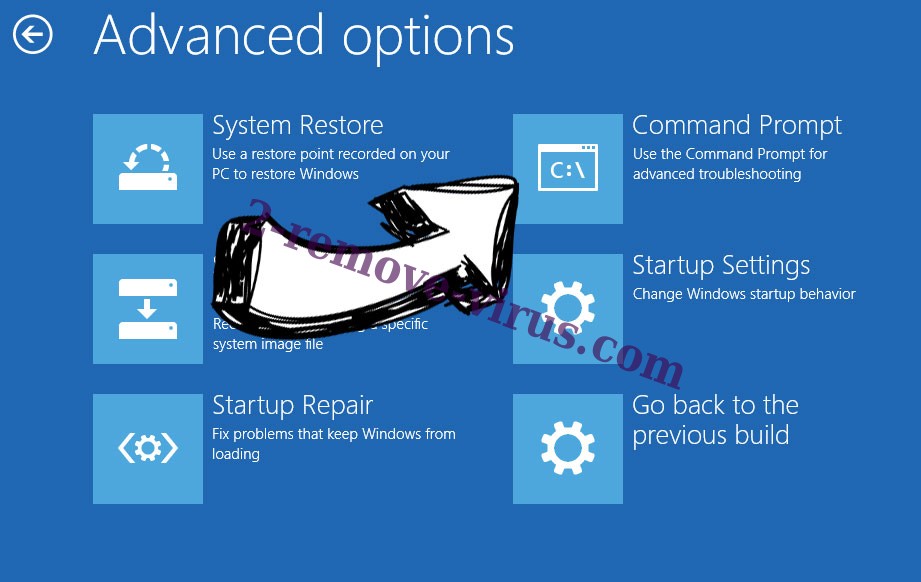
- In Command Prompt, input cd restore and tap Enter.


- Type in rstrui.exe and tap Enter again.


- Click Next in the new System Restore window.

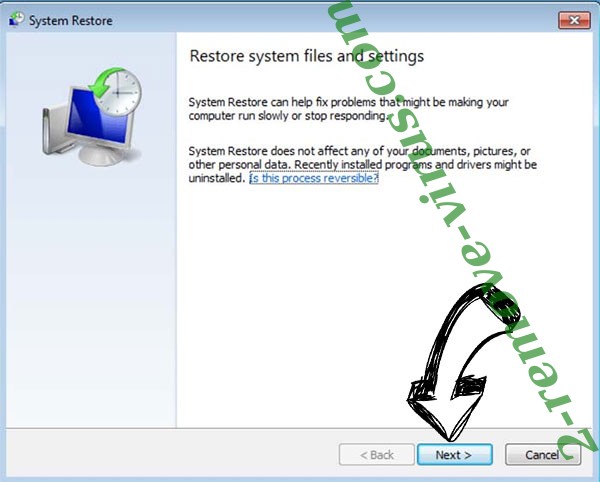
- Choose the restore point prior to the infection.


- Click Next and then click Yes to restore your system.


Site Disclaimer
2-remove-virus.com is not sponsored, owned, affiliated, or linked to malware developers or distributors that are referenced in this article. The article does not promote or endorse any type of malware. We aim at providing useful information that will help computer users to detect and eliminate the unwanted malicious programs from their computers. This can be done manually by following the instructions presented in the article or automatically by implementing the suggested anti-malware tools.
The article is only meant to be used for educational purposes. If you follow the instructions given in the article, you agree to be contracted by the disclaimer. We do not guarantee that the artcile will present you with a solution that removes the malign threats completely. Malware changes constantly, which is why, in some cases, it may be difficult to clean the computer fully by using only the manual removal instructions.
